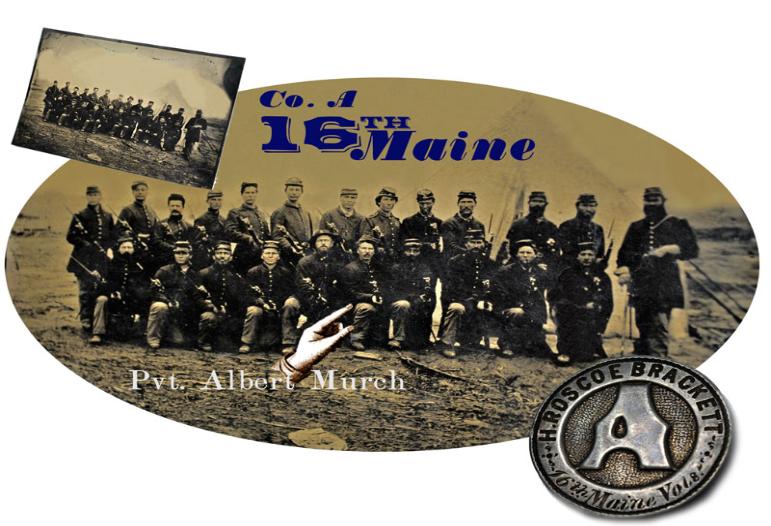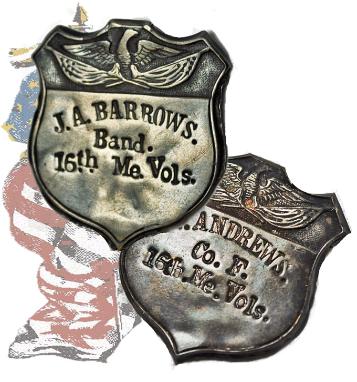

A rare half plate tintype captures the image of members of Co. A 16th Maine in the field with arms at the ready. Taken just prior to the Battle of Gettysburg, an old family notation identifies the young man indicated at center front, as Albert J. and his fellows of Co. A were already veterans of Antietam and Fredericksburg, the infamous Mud March and the horrors of Chancellorsville. A short while after the photographers visit, Pvt. Albert Murch would be one of sixty-five members of his regiment captured at Gettysburg. The regiment lost 148 men, killed, wounded & captured in the three day fight. The Bloody 16th was down to 275 officers his regiment only to be captured yet again at Weldon Railroad, Virginia. Murch was among 83 enlisted men and three line officers of the 16th Maine along with its commander Colonel Tilden himself, to be captured here. Col. Tilden and Lt. Davies together escaped the enemy’s clutches within twenty-four hours. Imprisoned earlier at Libby, this was the second POW escape for the wily Colonel Tilden. Not so fortunate Pvt. Albert Murch would die of disease as a POW at Salisbury, N.C., January 6, 1865.
Silver ID badge of: H. ROSCO BRACKETT
Present at Antietam, the Battles of Fredericksburg, Chancellorsville then Gettysburg, Musician Barrows would have been detailed as a litter bearer as was the custom for members of the Regimental Band. Barrows remained in service to the 16th throughout the Civil War as they saw action at such as the Battles of the Wilderness, Laurel Hill, Spotsylvania and Spotsylvania Court House as well as Totopotomoy, Cold Harbor, the Petersburg Siege, the Battle of the Mine Explosion and finally the actions of the Appomattox Campaign concluding with Appomattox Court

Barrows was a resident of Peru, Maine in the spring of 1862 when he threw his lot in with the boys of Co. C, 16th Maine Volunteer Infantry. Present at Antietam, the Battles of Fredericksburg, Chancellorsville then Gettysburg, Musician Barrows would have been detailed as a litter bearer as was the custom for members of the Regimental Band. Barrows remained in service to the 16th throughout the Civil War as they saw action at such as the Battles of the Wilderness, Laurel Hill, Spotsylvania and Spotsylvania Court House as well as Totopotomoy, Cold Harbor, the Petersburg Siege, the Battle of the Mine Explosion and finally the actions of the Appomattox Campaign concluding with Appomattox Court House, the surrender Lee and his army then the Grand Review in Washington D. C.
Abrums was a 20 year old Gorham, Maine native when he joined the 16th Maine Infantry on August 14, 1862. Two months later he would be detached to serve with the 2nd Maine Battery, Maine Mounted Artillery. In the thick of it with Dow’s 2nd Maine Battery at Gettysburg, would be recorded as missing in action until it had been established that he had been taken prisoner. He was imprisoned in Richmond till he died of fever in a Confederate hospital on 11/27.1863. His identification badge shown here was recovered by a skilled relic hunter with the aid of a modern day metal detector. (published in: Rebels & Yankees the Battlefields of the Civil War by Wm. C. Davis – p. 100 & 101)






